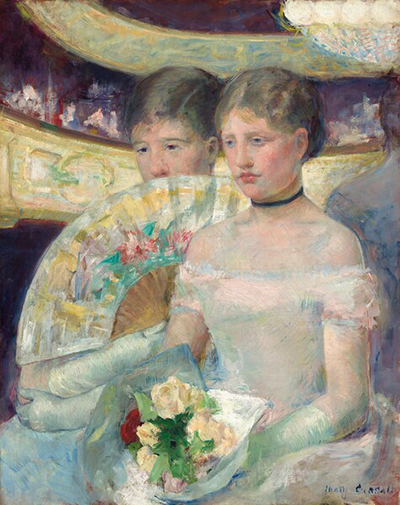A number of the Impressionists were inspired by the scenes of theatre, both on stage and from within the audience. Mary Cassatt was excited by the glamorous women who would adorn the loges as the French theatre scene went from strength to strength across the late 19th century.
This beautiful artwork features a couple directly in front of us attending a major event in their finest attire. The female takes the main focus, as was Cassatt's will in most cases, and she is stunning in a light, pastel-toned dress which fits tightly and is designed more for aesthetic value than comfort. She holds a bouquet of flowers in her hand and holds up a decorative fan, which has the visual impact of separating here from those that she is sat with. In essence, even with all the detail included elsewhere, this painting is all about the female figure in front of us - perhaps Cassatt envies here a little, and appreciates her status and beautiful appearance. Besides the couple there are several rows of seats with stunning decorative touches around the theatre. There is also a chandelier which hangs from above to add light, but is carefully cropped in half to avoid dominating the scene completely.
Theatre scenes was not the most common genre in which Cassatt worked but there are several other examples from her career which tackle these locations and she would put a lot of work into each one. Some may have been requested as commissions, but most simply addressed the beauty of these events and also followed on from the work of other members of the Impressionist movement. This was the traditional way in which women were seen in 19th century painting, as attractive and feminine, but later on Cassatt decided to draw attention to the less glamorous sides of their lives and provide a more comprehensive survey of life for women in that period, something that most male artists would shy away from, or perhaps even have little interest in.
The theatre scene would provide employment and inspiration for visual artists in a number of ways. Some would become involved in set design, for example, helping to build huge murals that would supplement these various productions. There would also be others that simply captured the atmosphere within personal artworks, with Degas famously focusing on ballerinas in a large series of paintings and drawings. There were then the commercial illustrators, such as Alphonse Mucha and Henri de Toulouse Lautrec who would use their talents to help promote various theatre shows by producing highly impactful advertisement posters which would be put up on display around the cities in which these productions were to be based. Many years before the arrival of modern technology and the new forms of advertising that this brought about, posters were an important method by which to drum up support for the arts industry. Some good examples of the work produced by Mucha, much of which was produced in Paris, include the likes of Amants, Bieres de la Meuse, Medea and Zodiac.




